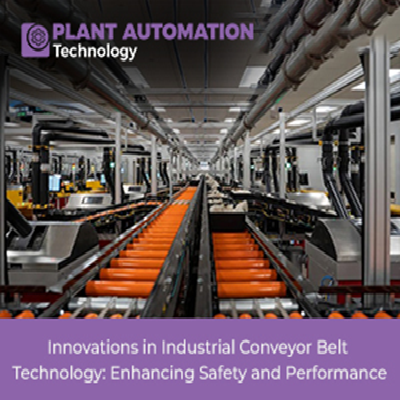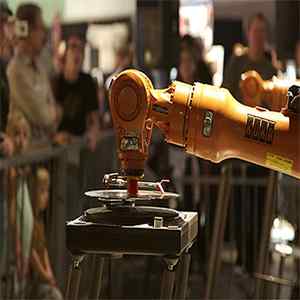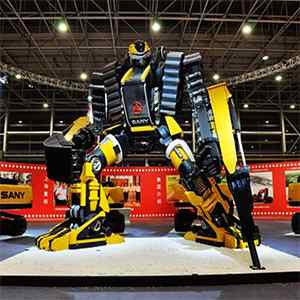Innovations in Industrial Conveyor Belt Technology: Enhancing Safety and Performance

Introduction
In recent years, industrial conveyor belt technology has seen considerable breakthroughs, resulting in substantial increases in safety requirements, efficiency, and overall performance. Conveyor belts serve a crucial role in many sectors, allowing for the smooth and dependable transfer of materials, components, and finished products throughout manufacturing and production processes. The advent of novel technology and materials has transformed industrial conveyor belt systems. This has ushered in an era of enhanced safety, productivity, and operational excellence.
In today's rapidly evolving industrial landscape, the demand for conveyor belts that offer superior performance, increased reliability, and improved safety measures is higher than ever. Innovations in conveyor belt technology have focused on addressing these requirements by introducing advanced materials, intelligent monitoring systems, automated maintenance solutions, and enhanced safety features.
Manufacturers have developed and incorporated advanced materials, such as polymers, composites, and reinforced fabrics. These materials exhibit exceptional strength, durability, and wear resistance. These materials enhance conveyor belt longevity and performance. This ensures they can withstand industrial environments while minimizing belt failures or downtime.
Intelligent monitoring systems have emerged as a vital component of conveyor belt technology. These systems utilize sensors, cameras, and IoT (Internet of Things) devices to continuously monitor critical parameters, including belt tension, speed, temperature, and vibration. Real-time data analysis enables proactive identification of potential issues, allowing operators to take preventative measures and optimize performance while reducing breakdowns or accidents.
Automation has transformed conveyor belt maintenance and cleaning processes. Automated maintenance systems can detect and address common issues such as misalignment, belt wear, and debris accumulation without manual intervention. This not only minimizes downtime but also enhances safety by reducing workers' exposure to hazardous conditions while working in close proximity to moving machinery.
Furthermore, the incorporation of enhanced safety features into conveyor belt technology has significantly contributed to improving worker safety and preventing accidents. Advanced safety switches, emergency stop systems, and conveyor guard mechanisms have been developed to detect and mitigate potential risks. This ensures the safety of workers and minimizes injuries or equipment damage.
Energy efficiency and sustainability have also played a significant role in conveyor belt technology advances. Regenerative drives that absorb and reuse excess energy, eco-friendly materials, and decreased waste output have all become critical design and manufacturing issues. By reducing energy consumption and carbon footprint, industrial conveyor belt systems contribute to sustainable operations.
Industrial conveyor belt technology innovations have improved safety, performance, and sustainability. These advancements enable industries to achieve higher levels of productivity, reliability, and operational efficiency while prioritizing workers' well-being and the environment. By embracing these cutting-edge technologies, industrial operations can unlock new opportunities for growth, competitiveness, and success in today's dynamic business landscape.
| Also Read: Predictive Maintenance for Conveyor Belts: Reducing Downtime and Costs |
Industrial Conveyor Belt Innovations
Advanced Material Selection
One of the key advancements in conveyor belt technology is the development of high-quality materials with superior strength, durability, and resistance to wear and tear. Manufacturers now utilize advanced polymers, composites, and reinforced fabrics that offer increased tensile strength, reduced elongation, and improved resistance to chemicals and temperature variations. These materials enhance conveyor belt performance and lifespan while ensuring safety in demanding industrial environments.
Intelligent Monitoring Systems
To enhance safety and prevent costly downtime, intelligent monitoring systems are integrated into conveyor belt setups. These systems utilize sensors, cameras, and other IoT (Internet of Things) devices to continuously monitor various parameters such as belt tension, speed, temperature, and vibration. Real-time data analysis helps identify potential issues or anomalies, allowing operators to take proactive measures to prevent breakdowns and optimize performance.
Automated Maintenance and Cleaning
Traditionally, conveyor belt maintenance and cleaning were labor-intensive tasks that involved manual inspection, lubrication, and belt tracking adjustments. Automation has revolutionized conveyor belt operations. Automated maintenance systems can detect and address issues such as misalignment, belt wear, and debris accumulation without human intervention, minimizing downtime and enhancing safety by reducing the need for workers to be in close proximity to moving machinery.
Enhanced Safety Feature
Safety is paramount in industrial settings, and conveyor belt technology has seen significant improvements in this regard. Innovations include advanced safety switches, emergency stop systems, and conveyor guard mechanisms. Safety switches can detect belt misalignment, slippage, or excessive tension and shut down the system. This prevents accidents and minimizes damage to the belt. Conveyor guarding mechanisms provide physical barriers to protect workers from pinch points and moving parts, further enhancing workplace safety.
Energy Efficiency and Sustainability
Another significant aspect of modern conveyor belt technology is its focus on energy efficiency and sustainability. Manufacturers are incorporating energy-saving features such as regenerative drives, which capture and reuse excess energy during deceleration, reducing overall power consumption. Additionally, conveyor belts are designed with eco-friendly materials and manufacturing processes that minimize environmental impact, including recycled materials and reduced waste generation.
Conveyor Belt Tracking Systems
Maintaining proper belt alignment and tracking is crucial for optimal performance and safety. Conveyor belt tracking systems use advanced sensors and control mechanisms to ensure the belt stays centered and aligned throughout the operation. These systems automatically detect any deviations or misalignments and make necessary adjustments in real-time. This minimizes belt wear, reducing spillage risk, and preventing accidents.
|
Also Read: Improving Supply Chain Efficiency: Conveyor Belt Manufacturers and Automation Solutions |
Modular Conveyor Belt Designs
Because of their flexibility and ease of installation, modular conveyor belt systems have grown in popularity. These belts are made up of individual modules or links that can be quickly swapped or altered to meet changing production requirements. Modular designs enable efficient belt repairs, save downtime during maintenance, and improve overall system reliability, boosting industrial safety and performance.
High-Speed Conveyor Belt Solutions
In certain industries, such as distribution centers and logistics, there is a growing demand for high-speed conveyor systems to handle large volumes of materials efficiently. Innovations in conveyor belt technology have led to the development of belts capable of operating at significantly higher speeds while maintaining stability and accuracy. These high-speed conveyor belts incorporate specialized materials, advanced tensioning systems, and precision control mechanisms to ensure safe and reliable operation even at elevated speeds.
Conveyor Belt Sorting and Diverting Systems
Conveyor belt sorting and diverting systems have become integral components in industries that require automated product sorting or routing. These systems use advanced sensors, cameras, and robotic arms to identify and categorize items on a moving conveyor belt. Based on predetermined criteria, the system can divert specific products to different output paths or workstations. This streamlines production processes, reducing manual labor, and improving overall efficiency and safety.
Integration with Industry 4.0 Technologies
Industrial conveyor belts are increasingly integrated with Industry 4.0 technologies to create "smart" conveyor systems. These systems leverage automation, data exchange, and real-time analytics to optimize operations. Integration with technologies such as artificial intelligence, machine learning, and predictive analytics allows for intelligent decision-making, proactive maintenance planning, and continuous process optimization. By harnessing Industry 4.0 potential, conveyor belt technology further enhances safety, productivity, and overall performance in industrial environments.
Considerations for Ergonomic Design
Conveyor belt systems increasingly include ergonomic design principles to increase worker safety and comfort. Height-adjustable conveyor systems accommodate a wide range of operator heights, lowering strain or injury risks during material handling duties. Anti-fatigue mats, ergonomic controls, and easy access to equipment and supplies are all standard components of conveyor workstations. These factors contribute to a safer and more comfortable workplace, lowering the risk of musculoskeletal illnesses and boosting general worker well-being.
Belt Cleaners and Scrapers
Maintaining a clean conveyor belt surface is essential for optimal performance and preventing material buildup. Innovations in conveyor belt technology have led to advanced belt cleaners and scrapers. These devices efficiently remove debris, dust, and residue from the belt surface, improving traction, reducing slippage, and preventing product contamination. By ensuring a clean belt, these innovations contribute to enhanced safety, productivity, and overall system performance.
Anti-static and Flame-resistant Belts
Certain industries, such as electronics manufacturing and mining, require specialized conveyor belts that offer additional safety features. Anti-static belts dissipate static electricity, preventing sparks that could cause fires or explosions in environments with flammable materials. Flame-resistant belts, on the other hand, are engineered to withstand high temperatures and resist burning, providing an extra layer of protection in applications where fire hazards exist. These specialized belts enhance safety and reduce accident risk in industries with specific safety requirements.
Conveyor Belt Tensioning Systems
Proper belt tension is vital for optimal performance and for preventing belt slippage or sagging. Innovations in tensioning systems have made it easier and more efficient to maintain the correct belt tension. Automatic tensioners utilize sensors and control mechanisms to continuously monitor and adjust the tension as needed. This ensures that the belt remains properly tensioned throughout its operation. By maintaining consistent tension, these systems improve safety by minimizing belt damage or unexpected belt failures.
Noise-reducing Technologies
Conveyor belt noise can be a significant issue in industrial settings, affecting worker comfort and potentially leading to hearing damage over time. To address this, innovations in conveyor belt technology have focused on noise reduction techniques. These include the use of specialized belt coatings, vibration-damping materials, and improved pulley designs. By reducing noise levels, these innovations create a quieter and more comfortable working environment while enhancing overall safety and well-being.
Conveyor Belt Training and Education
As conveyor belt technology evolves, proper training and education have become crucial for safe and effective operation. Manufacturers and industry organizations provide training programs on conveyor belt maintenance, safety protocols, troubleshooting, and best practices. These initiatives help operators and maintenance personnel stay updated on the latest advancements. This enables them to operate and maintain conveyor systems with confidence, minimizing risks, and optimizing performance.
Conclusion
Industrial conveyor belt technology has revolutionized the way materials are transported and processed in various industries. From improved tracking systems to modular designs, high-speed solutions, and integration with Industry 4.0 technologies, these innovations have significantly enhanced safety, efficiency, and performance. By embracing these advancements, industrial operations can optimize their processes, reduce downtime, and ensure a safer working environment for their employees.







